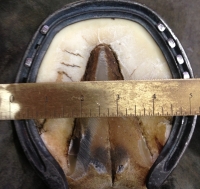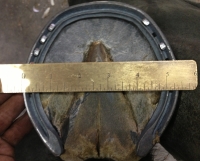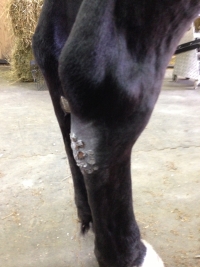Horses’ hooves are seldom perfectly uniform. If you took the right front shoe and nailed it on the left front foot, you would normally have to make at least a small adjustment to the shoe.
(In fact, some shoe manufacturers have started to make shoes in right and left patterns, which can lead to some interesting trips to the supply store. Often when reaching into a nearly empty box of shoes, I will find a bunch of unmatched lefts or rights because people haven’t realized that they are made in pairs. The store manager and I have a running joke about one-sided horses.)
Often, the medial (inside) branch of the hoof has a straighter shape with the bend starting a little closer to the heel. The lateral (outside) branch will be a little rounder with the bend starting closer to midway around. This is prevalent in hind feet, but can also be seen in fronts though to a lesser degree. It is a common occurrence and has nothing to do with distortion or flares.
As I have mentioned before, gait and conformation can and will affect the shape of a hoof. However, another thing that I believe is important to recognize is that lameness can also alter the hoof capsule.
When I am finished trimming a hoof and have removed the flares (distortion), I then measure the span of that hoof across the widest part. I do this to be more efficient in shoe fitting, but it also adds another reference to the overall picture of that horse’s well-being, just as shoe wear can be an indicator of oncoming problems. If I find a disparity in the width of the two “normal” front feet, or two “normal” hinds, I definitely take notice.
 Fig. 1
Fig. 1 Fig. 2
Fig. 2 Fig. 3
Fig. 3
To define disparity, at 1/8-inch and I notice; ¼-inch and I am looking at this horse very closely; 3/8-inch or more and I am very concerned.
Now before I go on, there is something called “high-low syndrome.” This is referring to front feet when one hoof is “dishy,” which means it is narrow and has a higher heel. The other is wide, flat, and has a much lower heel. High-low syndrome has plagued farriers and horsemen for many years. It will create the same width disparity, but not necessarily indicate a new or oncoming lameness. When I become concerned is when two feet, that I know are normal, start to become mismatched in width.
Fig. 1 is the right hind of the case horse. Fig. 2 is the left hind. The left hind has become wider because it is consistently bearing more weight than the right hind. This horse is protecting something on the right hind. In this case, it is obvious in Fig. 3. The right hock is quite “boggy,” and also has a nasty curb. I believe this situation gets very interesting when it isn’t as obvious and changes are happening more subtly.
One such example would be a horse that is training back into race condition after recovering from an injury to the suspensory ligament of one hind leg. The MRI may show the ligament is in good shape and the horse is training well, but if the opposite hoof is getting wider, then the injury is not 100-percent healed.
In the case of a recovering suspensory problem, my experience tells me that this is a harbinger of a poor, or short-lived, racing future. In the case of a well-performing racehorse that has not yet shown any significant lameness or injury, it can be the signal of a growing problem that may yet be averted.
Width disparity is not isolated solely in the hind hooves, but can be evident in fronts as well. In either case, I believe it merits a deeper look into that horse’s well-being and soundness.
So as much as we may like to ignore the fact, size definitely matters.
Veteran Standardbred farrier Steve Stanley of Lexington, Ky., authors a monthly column for Hoof Beats, the official harness racing publication of the U.S. Trotting Association. The American Farriers Journal Editorial Advisory Board member offers plenty of practical advice that will be of special interest regardless of the type of horses that you work with. Click here to read more from Steve Stanley's Hoof Beats series.








Post a comment
Report Abusive Comment